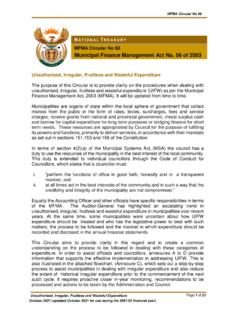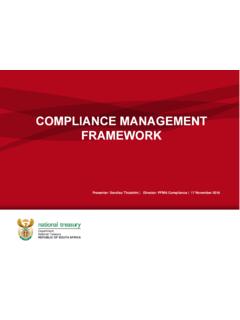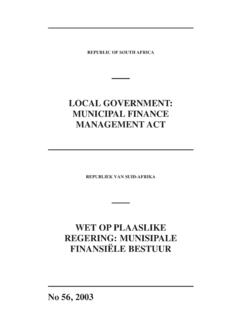Transcription of Annexure A: Irregular Expenditure Framework
1 Annexure A: Irregular Expenditure Framework Annexure A: Irregular Expenditure Framework 2 | P a g e Table of Contents CHAPTER 1 ..4 DEFINITIONS .. 4 CHAPTER 2 ..6 PURPOSE AND APPLICATION OF THE Framework .. 6 Purpose .. 6 Applicability .. 6 Irregular Expenditure incurred in prior year(s) .. 6 CHAPTER 3 ..7 RECOGNITION OF Irregular Expenditure .. 7 Recognition .. 7 CHAPTER 4 .. 10 ASSESSMENT, DETERMINATION AND/OR INVESTIGATIONS RELATED TO Irregular Expenditure .. 10 Assessment .. 10 Confirmation of Irregular Expenditure .. 10 Confirmation of Non-compliance .. 11 Determination .. 11 Investigation .. 12 CHAPTER 5 .. 13 RECOVERY, CONDONATION OR REMOVAL OF Irregular Expenditure .. 13 Recovery .. 13 Transfer to the Loss Control Function or another relevant function .. 13 Quantifying a debt (loss).
2 14 Raising a debt .. 15 Informing the responsible employee of the debt .. 15 Liability in law (if there are disputes) .. 16 Irrecoverable debt .. 16 Referral of Irregular Expenditure where no losses were 16 Annexure A: Irregular Expenditure Framework 3 | P a g e Referral of Irregular Expenditure where a fraudulent, corrupt or other criminal conduct was identified .. 17 Irregular Expenditure referred to Human Resource Function (paragraph 44 (a)) .. 17 Irregular Expenditure referred to the relevant authority for condonation (paragraph 44 (b)) .. 18 Irregular Expenditure referred to the accounting officer or accounting authority for removal (paragraph 44 (c)) .. 19 Irregular Expenditure referred to the South African Police Service .. 20 Irregular Expenditure ACCOUNTABILITY CYCLE .. 21 CHAPTER 6.
3 22 REPORTING OF Irregular Expenditure .. 22 Reporting .. 22 Reporting by the Accounting 22 Reporting by the Accounting 23 In-Year-Monitoring Report at National Level .. 23 In-Year-Monitoring Report at Provincial Level .. 23 CHAPTER 7 .. 25 RECORDING IN THE CHECKLIST AND LEAD SCHEDULE .. 25 CHECKLIST AND LEAD SCHEDULE .. 25 Recording in the checklist .. 25 Reporting in the note to the annual financial statements .. 26 CHAPTER 8 .. 29 PROCESS FLOW FOR Irregular Expenditure .. 29 APPENDIX A .. 30 EXAMPLE TEMPLATE: Irregular Expenditure CHECKLIST .. 30 APPENDIX B .. 31 EXAMPLE TEMPLATE: Irregular Expenditure LEAD SCHEDULE .. 31 APPENDIX C .. 32 EXAMPLE TEMPLATE: Irregular Expenditure IN YEAR-MONITORING AND REPORTING .. 32 Annexure A: Irregular Expenditure Framework 4 | P a g e CHAPTER 1 DEFINITIONS In this Framework , any word or expression to which a meaning has been assigned in section 1 of the Public Finance Management Act (PFMA), 1999 (Act No.)
4 1 of 1999), and regulations made in terms thereof, has the meaning so assigned, and assessment means a test conducted by a Loss Control Function or another relevant function1 to identify possible irregularities in transactions processed and to confirm the allegations of Irregular Expenditure ; checklist means a list of transgressions and alleged cases of Irregular Expenditure that are in the process of being dealt with; condonation means a process whereby the relevant authority acknowledges the Irregular Expenditure and pardons the action that has resulted in the incurrence of Irregular Expenditure ; determination means an informal assessment conducted by the Loss Control Function or another relevant function to examine or analyse the particulars of non-compliance in order to establish the facts and to determine the loss(es) related to the transaction; investigation means a formal probe conducted by a function performing investigations to analyse the particulars of non-compliance in order to establish the facts about the transaction and to determine whether any fraudulent, corrupt or criminal act has taken place; lead schedule means a summary of Irregular Expenditure to be disclosed in notes to the annual financial statements and the progress related thereto; non-compliance means the failure to comply with a legal requirement.
5 Removal means the process of eliminating the Irregular Expenditure from notes to the annual financial statements if it was not condoned by the relevant authority; and relevant authority means (a) The National Treasury, in the case where an employee or the accounting officer of a national department or constitutional institution, or an employee or the accounting authority of a Schedule 2, 3A or 3B public entity, was responsible for Irregular Expenditure ; and 1 Reference to another relevant function means a function assigned by the accounting officer or accounting authority to perform a task related to loss control management. Annexure A: Irregular Expenditure Framework 5 | P a g e (b) The relevant provincial treasury, in the case where an employee or the accounting officer of a provincial department or an employee or the accounting authority of a Schedule 3C or 3D public entity, was responsible for the Irregular Expenditure .
6 Annexure A: Irregular Expenditure Framework 6 | P a g e CHAPTER 2 PURPOSE AND APPLICATION OF THE Framework Purpose 1. The purpose of this Framework is to provide procedures to be followed by accounting officers and accounting authorities when dealing with Irregular Expenditure . Applicability 2. This Framework applies to all: (a) Departments; (b) Constitutional Institutions; and (c) Public Entities listed in Schedules 2 and 3 to the PFMA. Irregular Expenditure incurred in prior year(s) 3. Accounting officers of departments and constitutional institutions and accounting authorities of public entities must address previous cases of Irregular Expenditure in terms of this Framework . Annexure A: Irregular Expenditure Framework 7 | P a g e CHAPTER 3 RECOGNITION OF Irregular Expenditure Recognition 4.
7 Irregular Expenditure is incurred when the resulting transaction is recognized in the financial records of a department, constitutional institution or public entity in accordance with the relevant Accounting Framework . 5. For a department or a government component applying the Modified Cash Standards (MCS) to incur Irregular Expenditure , the non-compliance must be linked to a financial transaction. Although a transaction may trigger Irregular Expenditure , a department or government component will only record Irregular Expenditure when a payment pertaining to the non-compliance is actually made ( when the Expenditure is recognized in accordance with the Modified Cash Standards). 6. For a government component, a constitutional institution, a trading entity or a public entity listed in Schedules 2 or 3 to the PFMA applying Generally Recognised Accounting Practice (GRAP) or International Financial Reporting Standards (IFRS) to incur Irregular Expenditure , the non-compliance must be linked to a financial transaction.
8 Although a transaction may trigger Irregular Expenditure , a constitutional institution, government component, trading entity or public entity will only record Irregular Expenditure when a transaction is recognised as Expenditure in the Statement of Financial Performance in accordance with GRAP or IFRS, whichever is applicable. Annexure A: Irregular Expenditure Framework 8 | P a g e 7. Figure 1: Identification and Recognition of Irregular Expenditure 8. Figure 1 above indicates that for a transaction to constitute Irregular Expenditure , it must meet the following conditions (a) it must be incurred in contravention of, or not in accordance with legislation; and (b) it must be incurred upon recognition of a financial transaction as Expenditure recognized in terms of the recognition principles of Generally Recognised Accounting Practice (GRAP) or International Financial Reporting Standards (IFRS)
9 Payment pertaining to the non-compliance made in terms of Modified Cash Standards Departments Government Components Constitutional Institutions Government Components Trading Entities Public Entities listed in Schedule 2 & 3 to the PFMA Contravention of, or not in accordance with legislation Contravention of, or not in accordance with legislation Non-compliance Non-compliance Transgression is identified and reported Transgression is identified and reported Recognition Recognition Annexure A: Irregular Expenditure Framework 9 | P a g e (i) an Expenditure in accordance with the Accounting Framework applicable to departments and government components operating on a modified cash basis of accounting; (ii) a liability in accordance with the Accounting Framework applicable to government components, constitutional institutions, trading entities and public entities operating on an accrual basis of accounting.
10 Annexure A: Irregular Expenditure Framework 10 | P a g e CHAPTER 4 ASSESSMENT, DETERMINATION AND/OR INVESTIGATIONS RELATED TO Irregular Expenditure Assessment 9. Sections 38(1)(n) and 51(1)(h) of the PFMA require accounting officers and accounting authorities respectively, to comply and ensure compliance with this Act. Accounting authorities of public entities are also required to ensure compliance with any other legislation applicable to the public entity. 10. Accounting officers or accounting authorities must ensure that their respective departments, constitutional institutions or public entities operate in accordance with the provisions of applicable legislation. 11. This responsibility encompasses identifying the legislative universe which institutions must comply with.













![Public Audit Act [No. 25 of 2004] - Gov](/cache/preview/d/e/4/d/c/b/9/8/thumb-de4dcb982923f9470777b963db2987ca.jpg)


